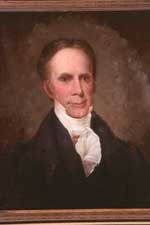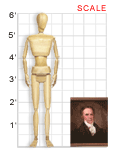VAM galleries including this work:
The Filson Historical Society || VAM Home
Nicola Marschall (1829-1917) after James R. Lambdin
PORTRAIT OF HENRY CLAY, after 1873
Oil on Canvas; 26-1/2" X 21-1/2"
1913.1.327, Gift of R.T. Durrett Estate
The Filson Historical Society
This portrait of 19th-century Kentucky statesman Henry Clay was once thought to be a copy of a Matthew Harris Jouett portrait of Clay but has since been identified and confirmed as being a copy of a portrait of Clay by James R. Lambdin, a noted 19th-century portraitist who lived in Louisville for five years in the 1830s. It is likely that R.T. Durrett, a prominent Louisville attorney and civic leader—and a passionate collector of items relating to Kentucky history—wanted to have a painting of Henry Clay in his collection and commissioned the work from Marschall. Because the commission came 25 years after Clay’s death, a new portrait would not be possible, so an earlier painting served as the “model.” The practice of copying portraits of well-known subjects was not uncommon at the time. Today, it sometimes makes it difficult for historical institutions and museums to determine who actually created a work.
In the portrait, Clay’s gaze seems slightly off-center; he does not appear to be looking directly at the viewer, though his gaze is alert. He is wearing a high white collar, there is a dimple in his chin, and his sideburns and eyebrows are graying.
About the Artist
Nicola Marschall was born in St. Wendell in Rhenish Prussia and is reputed to have had some training at the Dusseldorf Academy in Germany before his arrival in New Orleans in 1849. He lived briefly in Mobile, Alabama, before becoming an art, music, and dance instructor at the Marion, Alabama, Female Seminary. Marschall returned to Dusseldorf in 1857 and studied there and in Munich with Bernhard, court painter to the Wittlesbachs, before returning to America in 1858, after which he was again active in Alabama and New Orleans.
Marschall enlisted in the Confederate Army in January 1861, becoming chief draftsman for the engineering corps. At the request of Mrs. Napoleon Lockett, he designed the Confederate gray uniform, and some sources credit him with designing the “Stars and Bars” insignia for the Confederate States of America navy. That design became the first official flag of the Confederacy. Marschall was discharged in May of 1865 and married one of his former students, Eliza Marshall of Marion, Alabama, later that year.
This painting is thought to have been done after Marschall moved to Louisville in 1873. In 1876, he won a medal from the International Exhibition in Philadelphia for his portrait work. He maintained a Louisville studio until his death.
Classroom Ideas
Discussion: What do you think of the practice of copying paintings? What are the ethical issues involved? What would be the challenges of copying a work by someone else? Do you think it would be easy or difficult? Would it be more or less enjoyable than creating an original work? Could an art student learn techniques by copying art masterpieces (a common practice)? What artistic skills are required to copy a work? What artistic skills are required to create an original work?
What impression of Henry Clay does this portrait convey? Compare this painting to others of Henry Clay in the Kentucky Virtual Art Museum (Henry Clay by William Frye in the Kentucky Historical Society gallery and the Henry Clay portrait quilt in the Kentucky Library and Museum gallery).
Activity: Choose a historical figure and look at existing paintings of him or her. Then create your own painting, making an effort not to copy an existing work but using the works for reference as to the person’s appearance.
Links
You’ll find extensive information about Marschall, images of his works, and student activities in the Alabama Department of Archives and History’s online guide, Nicola Marschall: Artist of the Deep South.
[www.archives.state.al.us/marschall/]
See the copying process in action at the Russian Museum ArtsStudio, where artist-restorers copy artworks on request.
[www.artsstudio.com]
Master Class (PDF format), an article from the October 2002 Smithsonian magazine, describes how art students copy masterpieces at the Louvre as a way to learn.
[www.smithsonianmag.si.edu/smithsonian/issues02/oct02/pdf/smithsonian_october_2002_master_class.pdf]
See the Stars and Bars flag at the Flags of the World site.
[atlasgeo.span.ch/fotw/flags/us-csa1.html#starsbars]

